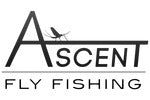
Euro Nymphing Part 4: Approaching & Dissecting the River

In parts 1-3 of our Euro Nymphing Series, we broke down the anatomy of Euro Nymphs, Euro Rods & Reels, and how to make your own pro-style euro leaders. Now that you are equipped with all of the tools of the Euro nymphing trade, its time to head to the water. Hold on there for a second! I know you’re anxious to get your line in the water, but before you start casting, we need identify the sweet spots you’ll want to target with your new rig and how best to approach them.
Target the Prime Water
A euro nymphing rig properly applied in the correct spots allows the angler to dissect the river and extract fish like a skilled surgeon! The general rule is that 90% of trout will be found holding and feeding in roughly 10% of the river. The three primary characteristics of the waters that we will be target with our euro rigs are they 1. Should have a sustained, moderate fast current; 2. We will focus on seems – those points of food concentration and current where a line of fast water moves around physical structure and is bordered by lines of calm water; 3. We will be targeting deeper water that provide the fish with cover and a sense of security. These pieces of prime water are going to be made up of lateral habitat – the mid-depth shelves found running parallel to the shore, pocket water – the deep eddies and downstream seams created by isolated boulders and trees laying in the current, and the Head and Tail of Pools – those zones of transition where the riffles drop food at the top of pool, and collect and channel food at the back of the pool.
Plan Your Attack
After we’ve identified the prime pieces of habitat that we wish to target, we need to position ourselves downstream and within range of the target. This downstream positioning is vital as there is no mending across multiple seams and currents with this method. A common error of the fly fisher is that when fishing across multiple current this creates drag, inhibits their flies from from reaching the feeding zone while being dragged unnaturally through the water. If a bird were to observing a euro nymph angler from above their path would carve a constant zig-zag across the breadth of the river, constantly moving and always looking upstream.
Stay in your lane
Back to our surgeon analogy, after we have moved into position downstream of our target, our we will cast and draw our line and flies through one seam at a time. With each cast, our flies, leader, and sighter will all enter the same seam, we will quickly elevate our rod tip, establishing tension and contact between the tip of the rod and the flies on the bottom of the river, and then guide those flies downstream with subtle adjustments of the rod tip. Once we have cleanly and thoroughly drifted and extracted the fish from that seam with a couple of casts, we move a foot to the right or left and proceed to dissect the next seam and so on.
Keep it close
In order to avoid having your drift muddled by cross currents, you should only target seams within the reach of the tip of your rod (ie. If you have a comfortable 2’ reach and are fishing a 10’ euro rod, the furthest seams you can target should be within 10’-12’ on either side of where you are standing.) The upstream cast should not exceed two rod lengths (ie. If your effective reach with your arm and a standard euro rod is 12’, your upstream cast should not exceed 24’). As soon as the drift comes parallel with you in the river, pick it up, recast, and start your next drift.
Stay tuned for part 5 of our Euro Nymphing series where we break down the Tuck Cast!
Fly of the Month
Pattern: Fat Albert
Sizes: 6-10

Often the biggest and baddest bug in the fly box, the Fat Albert might need a row all to itself. The titanic of terrestrial patterns, this fly is truly unsinkable! Whether you are fishing in Patagonia, the Rocky Mountains, or Alaska, the Fat Albert looks like a juicy steak to hungry trout, so hold on tight as they eagerly race to take your fly!
Dry/Wet: Dry
Fly Category: Attractor Pattern
Family: Stonefly, Terrestrial
Species: Beetle, Grasshopper, Cicada, Cricket
Life Stage: Adult


